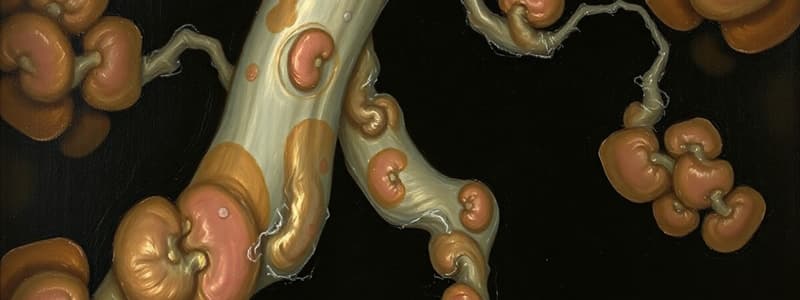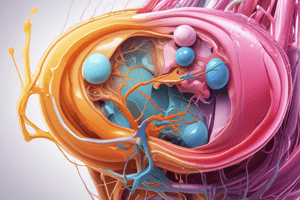Podcast
Questions and Answers
During the oliguric phase of kidney injury, which hematologic finding is most concerning?
During the oliguric phase of kidney injury, which hematologic finding is most concerning?
- Thrombocytopenia
- Leukocytosis (correct)
- Anemia
- Eosinophilia
Which of the following neurological manifestations indicates a worsening condition in a patient during the oliguric phase?
Which of the following neurological manifestations indicates a worsening condition in a patient during the oliguric phase?
- Seizures (correct)
- Headache
- Difficulty concentrating
- Fatigue
A patient in the oliguric phase has a BUN of 60 mg/dL and a serum creatinine of 3.5 mg/dL. What does this indicate?
A patient in the oliguric phase has a BUN of 60 mg/dL and a serum creatinine of 3.5 mg/dL. What does this indicate?
- Improved kidney function
- Stable kidney function
- Normal kidney function
- Worsening kidney function (correct)
Which type of infection poses the greatest risk to a patient in the oliguric phase?
Which type of infection poses the greatest risk to a patient in the oliguric phase?
A patient in the oliguric phase reports increasing fatigue and difficulty concentrating. What is the most likely cause of these symptoms?
A patient in the oliguric phase reports increasing fatigue and difficulty concentrating. What is the most likely cause of these symptoms?
Flashcards
Oliguric Phase
Oliguric Phase
A phase of AKI marked by decreased urine production.
Leukocytosis
Leukocytosis
An elevated white blood cell count, indicating a possible infection.
Waste Product Accumulation in AKI
Waste Product Accumulation in AKI
A buildup of nitrogenous waste products in the blood due to impaired kidney function.
Increased BUN and Creatinine
Increased BUN and Creatinine
Signup and view all the flashcards
AKI Neurological Disorders
AKI Neurological Disorders
Signup and view all the flashcards
Study Notes
- Oliguric phase is marked by hematologic disorders, including leukocytosis
- Leukocytosis indicates a high risk of infection, which may be fatal
- Patients are susceptible to urinary and respiratory infections during this phase
- Waste product accumulation leads to increased BUN and serum creatinine levels
- Neurologic disorders manifest as fatigue and difficulty concentrating.
- Severe neurological symptoms include seizures, stupor, and coma.
Studying That Suits You
Use AI to generate personalized quizzes and flashcards to suit your learning preferences.




